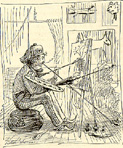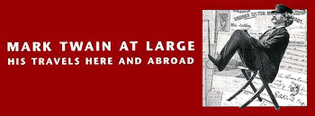About the Mark Twain Papers
History and holdings
History
The Mark Twain Papers contain the voluminous private papers of Samuel Langhorne Clemens (Mark Twain). Before his death in 1910, Clemens passed these documents to his official biographer, Albert Bigelow Paine, who published sparingly from them until his death in 1937. From then until 1979, four successive editors served as literary executors for Clemens's estate and custodians of the Papers: Bernard DeVoto in Widener Library at Harvard University, Dixon Wecter at the Henry E. Huntington Library in San Marino, California, and later, Henry Nash Smith and Frederick Anderson, both at UC Berkeley.
After stays at Harvard and the Huntington, these documents by and about Mark Twain — the core of the collection — were ultimately deposited in the UC Berkeley Library in 1949. They were officially bequeathed to the University of California in 1962 upon the death of Mark Twain's sole surviving daughter, Clara Clemens Samossoud. In 1971, the Papers became part of The Bancroft Library.

Photo: Mark Twain in London, aged 63. Photographer: Russell & Sons. Date: 4 July 1899. [Mark Twain Papers, PH00226]
Current holdings
Since 1949, the university has added hundreds of original documents to that core collection: letters; literary manuscripts; a dozen scrapbooks with unique clippings of the author’s newspaper work; first editions and other rare printings; photographs; and various important collateral documents, such as the diaries of Mark Twain's secretary, Isabel V. Lyon.
Complementing and greatly enlarging the core archive of original documents is a working archive of photocopies and transcriptions of documents held elsewhere. This working archive consists primarily of letters written by Clemens, his wife, and their three daughters. It also includes letters to each of them, the dozen major literary manuscripts (published and unpublished) that are known to survive, books from Mark Twain’s personal library, photographs, drawings, and other artifacts. This assemblage of copies is the result of global cooperation among hundreds of institutions and individuals since the 1960s, and has been a primary focus of the Mark Twain Project, the editorial enterprise housed within the Papers.
The combination of original and photocopied documents now makes it possible to read virtually every document in Mark Twain's hand known to survive, without ever leaving UC Berkeley:
- Some 50 notebooks kept by Clemens between 1855 and his death in 1910.
- Approximately 12,000 letters by him or his immediate family, with three new letters still found each week.
- More than 19,000 letters to the family.
- About 600 literary manuscripts that Mark Twain left unpublished (and often unfinished), many with his typed and revised copies of the manuscript.
- Manuscripts ranging from mere fragments to complete drafts (including chapters Mark Twain wrote but decided to leave out) for almost all of the books he published, and for perhaps a tenth of his published short works — sketches, essays, editorials, speeches, and poems.
- Working notes, typescripts, and magazine proofs for various titles.
- First editions and other lifetime editions, including American, English, Australian, Canadian, and Continental European printings of his various books.
- About 150 books from his library, usually with marginalia.
- Uncounted business documents, clippings, scrapbooks, interviews, bills, receipts, contracts, photographs, and a handful of objects originally owned by him.
Since 1980, the growing archive of original and photocopied documents, as well as the editorial project based in that archive, have been under the direction of Robert H. Hirst.
Digital exhibits
Samuel Clemens spent much of the years 1861-66 in Nevada Territory and California. Selections from his letters, notebooks, autobiographical dictations, and scrapbooks, as well as mining deeds and photographs, give an inside look at some of the experiences, people, and places that provided material for stories and literary works throughout his career.
Mark Twain in the West was created as an exhibition using surrogate materials for Elmira College’s State of Mark Twain Studies conference, July 2013.
Mark Twain was a hardworking and prolific writer, but how did he spend his time when he was free to relax and amuse himself? Mark Twain at Play brings together manuscripts, documents, notebooks, albums, vintage photographs, and other artifacts from The Bancroft Library's Mark Twain Papers to answer that question.
From October 2008 through April 2009, Mark Twain at Play was the inaugural exhibition in the newly retrofitted and renovated Bancroft Library.
Mark Twain, publicly and privately, expressed strong opinions about painting and sculpture. His commentary was wry, lively, and sometimes eccentric. On occasion, he also illustrated his literary works and letters with his own sketches.
Drawing from the Mark Twain Papers of The Bancroft Library and from the publications of the Mark Twain Project, the Mark Twain Takes on Art exhibition shares with the public the author’s art commentary and drawings. The exhibit was physically installed in Doe Memorial Library from April through June 2001.
Mark Twain at Large: His Travels Here and Abroad
This exhibition features selected items elucidating Mark Twain’s travel adventures and his attitudes about the places and cultures he explored. It was installed in the Heller Gallery of The Bancroft Library from September through December 1990.
The 60-page printed catalog of the complete exhibition, designed by Mary Scott, won the Katherine K. Leab and Daniel J. Leab American Book Prices Current Exhibition Catalogue Award, Division 2, in 2000.




